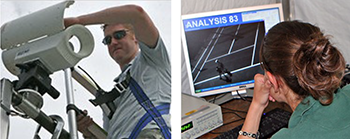VIEW AND DOWNLOAD WORLD TENNIS GAZETTE VOL. 13 NO. 2
By JOHN MARTIN

John Martin
SAN DIEGO — When the US Open decided to install Hawk-Eye Live cam-eras on 15 of the 17 courts at the Billie Jean King National Tennis Center, the desire to keep down the number of people on site was ascribed to the Covid-19 pandemic.
But it did worry some of the hundreds of certified linespeople. With tournaments cancelling around the world due to the virus and Hawk-Eye Live on the rise, they wondered: Is this the beginning of the end?
As it happened, the USTA hired fewer than 80 of the 300-plus people who ordinarily call the lines. This caused shudders because linespeople are independent contractors with no presumed rights as employees.
In its first week, Hawk-Eye Live made only 14 errors out of 225,000 line calls, according to James Japhet, the managing director of Hawk-Eye North America. He told The New York Times, “Fourteen is a larger number than we hoped for.”
“It’s not perfect,” said Bob Christianson, a respected linesperson for 40 years. “It makes quick decisions, obviously, and people seem to gravitate more towards technology being correct than human beings. We give technology the benefit of the doubt. “We’ve had to relearn how to call lines with Hawk-Eye,” said Christianson.
“It calls a lot more balls in than we see. I see space between the line and a ball I call it out, obviously. Hawk-Eye comes down from the rafters, and sees the ball over the line, which is good.”
Nevertheless, there will be disruptions.. “I feel sad,” he said, ”for the middle-aged and younger full-time linesman at the top level who are probably going to lose jobs.”
Tournament director Stacey Allaster said that some current linespeople would be absorbed into other tournament jobs.
“Not to the extent that they’re currently employed,” said Christianson.
“Each court still has to have a chair, we know that, but they also need two other officials, one to do bathroom breaks with the players,” he said, “and two, you need somebody to do ball changes.”
As the Open was ending, Allaster said using Hawk-Eye Live had been an experiment that proved “a terrific success. There’s no debate.”
“A few data points for you,” she said. “Over the four weeks, Hawk-Eye Live has made a total of 304,000 calls,” she said. The four weeks included time for testing and staging a pre-US Open tournament ordinarily held in Ohio.
There was a separate category, she revealed. “Close calls, 11,901,” she told reporters. “Those are the red or green that the chair umpire is seeing. The close calls during the US Open, just over 9,000.”
Until we learn more, Close Call is a mystery. Sounds like a big number., but it could suggest more linespeople will be needed — or not.
“This was a 2020 focus. We made no decisions around 2021,” Allaster concluded. “But this was a great effort on behalf of all of our competition team and the Hawk-Eye team members, both tours, to support the experiment. We couldn’t be more pleased with how it has been executed.”